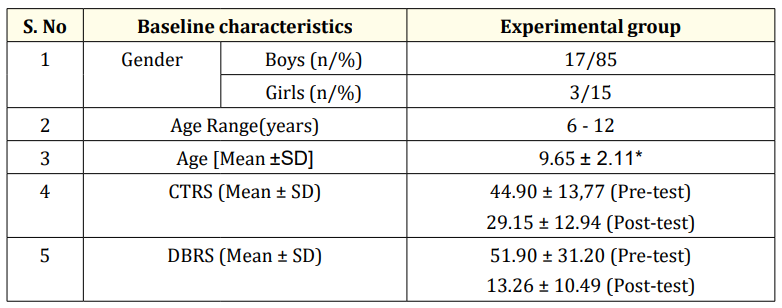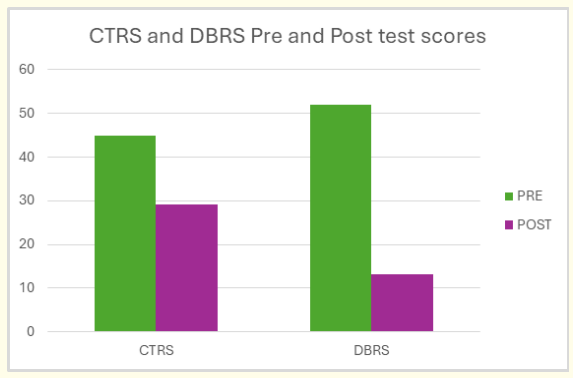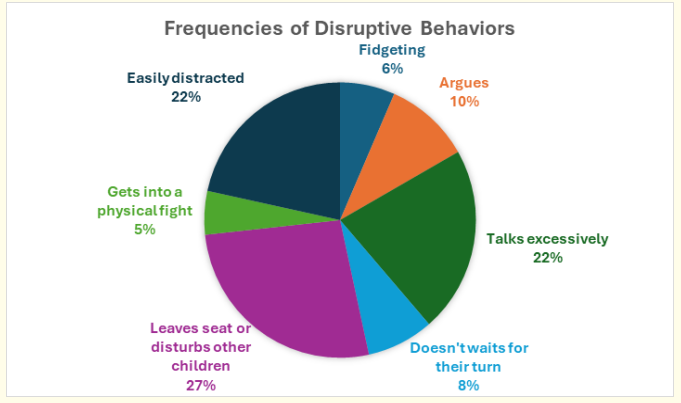Keshavaram P1 and Yamuna C2*
1Assistant Professor, Department of Occupational Therapy, MCHP, Manipal Academy of Higher Education, Manipal, India
2Professor, KMCH College of Occupational Therapy, Coimbatore, India
*Corresponding Author: Yamuna C, Professor, KMCH College of Occupational Therapy, Coimbatore, India.
Received: October 08, 2024; Published: November 22, 2024
Citation: Keshavaram P and Yamuna C. “Effectiveness of Combining Token Economy and Response Cost among Children with Attention Deficit Hyperactivity Disorder to Reduce Disruptive/Impulsive Behavior in Classroom”. Acta Scientific Paediatrics 7.12 (2024): 02-09.
Attention-deficit/hyperactivity disorder (ADHD) is a chronic condition that significantly affects attention, impulsivity, and hyperactivity, impacting approximately 3% to 5% of the elementary school-age population. Given its prevalence, the use of effective interventions to reduce classroom-related impairments in students with ADHD is essential for school personnel.
Aim: To evaluate the effectiveness of combining token economy and response cost interventions to reduce disruptive and impulsive behaviors in the classroom among children with ADHD.
Method: A single-group pre-test and post-test quasi-experimental design was used. Twenty children diagnosed with ADHD were selected for the experimental group using the Vanderbilt ADHD Teacher Rating Scale as the screening tool. The Conners Teachers Rating Scale (CTRS) and the Disruptive Behavior Rating Scale (DBRS) were employed as outcome measures. The intervention involved a combination of token economy and response cost strategies, applied over a six-week period.
Results: Statistical analysis of the post-test scores revealed a significant reduction in disruptive behavior, with CTRS scores averaging 15.75 (95% CI: 11.79 - 19.70) and DBRS scores averaging 20.70 (95% CI: 17.56 - 23.83), both showing a p-value of 0.000.
Conclusion: This study demonstrates that combining token economy and response cost interventions effectively reduces disruptive behavior in children with ADHD. Occupational therapists can implement these strategies as part of classroom-based interventions to manage behavior in children with ADHD.
Keywords: Token Economy; Response Cost; Disruptive Behavior; Classroom Intervention
ADHD: Attention Deficit Hyperactive Disorder; CTRS: Conners Teachers Rating Scale; DBRS: Disruptive Behavior Rating Scale
ADHD is a neurobiological behavioral disorder characterized by chronic and developmentally inappropriate levels of inattention, impulsivity, and sometimes hyperactivity. It is primarily caused by neurological inefficiencies in areas of the brain responsible for controlling impulses and executive functions such as self-regulation and management. ADHD reflects a developmental delay in inhibition, self-control, and self-management [1].
Inattention in ADHD involves various components, including arousal, alertness, selective or focused attention, distractibility (the ability to focus on relevant stimuli while ignoring irrelevant ones), attention span, and sustained attention (the ability to maintain focus over time). Children with ADHD particularly struggle with sustaining attention over extended periods [2,3].
Another core characteristic of ADHD is impulsivity, or difficulty controlling impulses. Impulsivity, more than inattention, often distinguishes children with ADHD from typically developing children or those with other disorders [4].
Hyperactivity is the third key feature of ADHD. This symptom can vary depending on the environment, often worsening in less stimulating settings. Many children with ADHD display excessive motor activity, though not all. They often exhibit hyperactivity, impulsivity, and rule-governed behavior deficiencies, leading to inconsistent task performance. Effective intervention strategies typically involve giving clear directions, using consistent discipline methods, and incorporating behavior management techniques [5].
In classrooms, ADHD symptoms such as difficulty sitting still, speaking out of turn, unfinished assignments, and daydreaming during instructions are often the first signs noticed by teachers. The ability of a child to focus on work with minimal interruptions often plays a crucial role in academic success. However, without appropriate instructional strategies and interventions, children with ADHD may struggle with their schoolwork and social interactions [6].As students with ADHD progress into higher grades, such as middle school, the increasing academic and organizational demands may require greater academic and behavioral [7].
Disruptive behavior refers to actions that interfere with a student’s learning, the learning of their peers, or the teacher’s ability to conduct classroom activities. It is often linked to behaviors that violate social norms and disrupt the flow of the classroom environment. Disruptive behaviors in school settings can include attention-seeking, distracting others, calling out in class, and leaving one’s seat without permission. These behaviors are typically triggered by specific classroom situations, such as long instructional periods or tasks the student finds particularly challenging [8]. These interactions within the classroom setting contribute to the complex nature of disruptive behavior observed in students with ADHD.
This study utilized a quantitative, single-group pre-test and post-test quasi-experimental design. A total of 20 children, aged 6-12 years, diagnosed with combined-type ADHD were included. Both male and female participants were considered. Children presenting with co-morbid conditions such as physical disabilities, subnormal intelligence, communication disorders, or visual and hearing impairments were excluded. The project was reviewed and approved by the Institutional Research Committee.
The Vanderbilt ADHD Diagnostic Parent Rating Scale (VADPRS) and Teacher Rating Scale (VADTRS) are specialized tools designed to assess DSM-IV symptoms of ADHD in children aged 6-12 years. These scales include separate forms for parent and teacher evaluations. The teacher version contains 35 items, each rated on a scale from 0 to 3. Additionally, there are 3 items assessing academic performance and 5 items evaluating classroom behavior, scored from 0 to 5 (with 5 indicating above-average behavior or performance). Based on the teacher’s ratings, children are classified into ADHD subtypes: predominantly inattentive, mostly hyperactive/impulsive, or combined inattention/hyperactivity [9].
The outcome measures used in the study were the Conners Teachers Rating Scale - Revised (S) and the Disruptive Behavior Rating Scale-2nd Edition (Teacher’s version).
The Conners’ Teacher Rating Scale (CTRS-R), part of the Conners’ Rating Scales - Revised, was designed to assess behavioral issues in children and adolescents through a multimodal evaluation process. This tool includes forms for parents, teachers, and adolescent self-reporting. The teacher version is suitable for children aged 3 to 17 years. The CTRS-R is available in two formats: the Long Form (CTRS-R:L), which contains 59 items, and the Short Form (CTRS-R:S), which includes 28 items. Teachers rate the frequency of specific behaviors on a four-point scale, ranging from “Not true at all (Never)” to “Very much true (Very often)”.
The Disruptive Behavior Rating Scale (DBRS) is a 35-item screening tool completed by teachers to detect symptoms of conduct disorder, oppositional defiant disorder, and ADHD in children and adolescents. For each item, teachers rate the child’s behavior on a scale ranging from “Not at all” to “Very much,” with an option to mark “DK” for “Don’t know” if they are unsure of the answer. The DBRS is designed for children aged 5 and older and takes approximately 5-10 minutes to complete. Studies have shown that the DBRS is both valid and reliable across diverse study samples (Erford). The outcome measures used were Conners Teachers Rating Scale -Revised (S) and Disruptive behaviour rating scale-2nd Edition (Teachers version).
Written consent was obtained from the institutional head before conducting the study. A total of 36 children with ADHD were initially screened using the Vanderbilt ADHD Teacher Rating Scale (VADTRS). Out of these, 20 children who met the inclusion criteria were selected for the study. A pre-test assessment was administered by the class teachers using the Conners Teachers Rating Scale (CTRS) and the Disruptive Behavior Rating Scale (DBRS). The class teachers were provided with instructions on the intervention protocol, which involved a combination of token economy and response cost strategies over a 6-week period (3 sessions per week, each session lasting 3 hours). Following the intervention, a posttest assessment was conducted at the end of the 6th week. The collected data were statistically analyzed using SPSS version 22.
Initially, a general discussion was held with the teachers to review the study protocol, and they were briefed on identifying and managing disruptive behaviors. The intervention sequence was explained as follows
This table provides a structured overview of the weekly intervention plan for managing classroom behavior in children with ADHD.

Figure 1: Weekly Intervention plan for children with ADHD.
Figure 2: Token and Reinforcers used for Reducing Disruptive Behavior in Children with ADHD.
Data for this study were collected using the Conners Teachers Rating Scale (CTRS) and the Disruptive Behavior Rating Scale (DBRS) before and after the intervention. A total of 36 children with Attention Deficit Hyperactivity Disorder (ADHD) were initially screened, and 20 children who met the selection criteria were included in the study. The children were between the ages of 6 and 12 years. The study involved a single experimental group that received a combined intervention of token economy and response cost. The raw scores of the experimental group were analyzed statistically using SPSS version 22, with paired “t” tests and descriptive statistics applied. The following comparisons were made using the paired “t” test: demographic details of the participants, descriptive statistics of pre- and post-test scores from the CTRS and DBRS (Table 1), and a comparison of pre- and post-test scores from the CTRS and DBRS within the experimental group (Table 2).

Table 1: Demographic Profile of Children with ADHD
SD: Standard Deviation; CTRS: Conners Teachers Rating Scale; DBRS: Disruptive Behavior Rating Scale
The above mentioned table shows that there is a decrease in mean and standard deviation in their post-test scores
than the pre-test scores of CTRS and DBRS.

Table 2: Comparison of Pre- and Post-Intervention Scores on CTRS and DBRS for Children with ADHD
*Significance - p-value.
The above tables represent that from the pre and post-test score of the experimental group, the t-value and mean value of CTRS and DBRS
has shown 0.00 significance.

Chart 1: CTRS and DBRS Pre and Post-Test Scores of Children with ADHD.

Chart 2: Frequencies of Disruptive Behaviors Exhibited by Children with ADHD.
Data for this study were collected using the Conners Teachers Rating Scale (CTRS) and the Disruptive Behavior Rating Scale (DBRS) before and after the intervention. A total of 36 children with Attention Deficit Hyperactivity Disorder (ADHD) were initially screened, and 20 children who met the selection criteria were included in the study. The children were between the ages of 6 and 12 years. The study involved a single experimental group that received a combined intervention of token economy and response cost. The raw scores of the experimental group were analyzed statistically using SPSS version 22, with paired “t” tests and descriptive statistics applied. The following comparisons were made using the paired “t” test: demographic details of the participants, descriptive statistics of pre- and post-test scores from the CTRS and DBRS (Table 1), and a comparison of pre- and post-test scores from the CTRS and DBRS within the experimental group (Table 2).
The use of token reinforcement systems and response cost interventions in school settings has garnered significant attention as an alternative to stimulant medication for managing Attention Deficit Hyperactivity Disorder (ADHD). A response cost system involves losing privileges, tokens, or points in response to inappropriate behavior and may be incorporated into a token economy. Research suggests that combining positive reinforcement with a penalty system tends to be more effective [1]. Token economies provide impulsive children with a tangible incentive to exhibit appropriate behavior and avoid negative consequences [11]. Thus, the primary aim of this study was to evaluate the effectiveness of combining a token economy with a response cost system to reduce disruptive and impulsive behavior in the classroom among children with ADHD.
The study was conducted with 20 school-aged children diagnosed with ADHD from special schools in and around Coimbatore, India. The group comprised 17 boys and 3 girls, with a mean age of 9.65 years. intervention lasted six weeks, with three sessions per week. During the intervention, the children received behavioral strategies combining both token economy and response cost during their class hours (Figure 1). The most frequent disruptive behavior observed in this study was “leaving seat or disturbing other children,” which accounts for 27% of the total. Both “easily distracted” and “talks excessively” each represent 22% of the observed behaviors. “Fidgeting” makes up 6%, while “arguing” constitutes 10%. “Doesn’t wait for their turn” was responsible for 8% of the disruptions, and the least frequent behavior observed was “getting into a physical fight,” which occurs 5% of the time (Chart 2). These disruptive behaviors gradually decreased as the children became motivated to earn tokens and understood that inappropriate behavior would result in token loss (Figure 2).
The main objective of the study was to assess the level of impulsivity in the classroom among children with ADHD, using the Conners Teachers Rating Scale (CTRS) and the Disruptive Behavior Rating Scale (DBRS) as outcome measures. Pre-test results showed a relatively high level of impulsivity, which gradually decreased throughout the intervention, as reflected in the post-test scores using the same outcome measures.
The analysis of pre- and post-test CTRS and DBRS scores revealed a significant difference in the mean values (Table 1, Chart 1). Further statistical analysis confirmed a significant reduction in disruptive behaviors with a p-value of 0.000 (Table 2), demonstrating the effectiveness of the combined token economy and response cost intervention in reducing disruptive behaviors in children with ADHD.
Previous research comparing the effectiveness of token economy systems, response cost conditions, and a combination of both in reducing problem behaviors and improving academic engagement in first-grade classrooms found that the token economy and combination conditions were the most effective [10]. Similarly, in the current study, the combination intervention reduced the frequency of disruptive behaviors and encouraged more appropriate classroom behavior as children worked to earn tokens. Teachers also utilized the tokens to enhance academic performance and attendance.
Another study in rural elementary schools similarly found that a combined token economy and response cost system was the most effective at reducing disruptive behaviors and increasing academic engagement, further supporting the findings of the present study [10]. In both studies, children earned tokens for appropriate behavior, which could be exchanged for rewards, while tokens were taken away for disruptive behavior.
As one of the study objectives was to identify the most common disruptive behaviors in the classroom, the observation revealed that the most frequently observed behaviors included leaving one’s seat and disturbing others (94 instances), talking excessively (77 instances), and becoming easily distracted (76 instances).
Feedback from instructors during the intervention was positive, noting that children were more likely to follow instructions, stay on task, and display desired behaviors when other students were praised and rewarded. The token chart displayed in the classroom motivated students to earn more tokens than their peers, further promoting appropriate behavior.
In conclusion, the findings of this study support the use of a combined token economy and response cost strategy as an effective occupational therapy intervention for reducing disruptive behaviors Occupational Occupational therapists often employ behavioral approaches, including reinforcement and token economies, to enhance classroom performance, as well as time-out and response cost methods to reduce maladaptive behaviors [12].
This study confirms that combining a token economy with a response cost system is an effective intervention for reducing disruptive behaviors in children with Attention Deficit Hyperactivity Disorder (ADHD) in the classroom. The intervention led to a noticeable reduction in impulsivity and common disruptive behaviors, such as being easily distracted, leaving their seat, disturbing classmates, and excessive talking during lessons. Occupational therapists can incorporate this combined approach alongside other behavioral strategies to effectively manage and reduce disruptive behaviors in children with ADHD in classroom settings.
The authors would like to thank the special schools and the children who took part in the study.
There was no any financial interest or any conflict of interest existed.
Copyright: © 2024 Keshavaram P and Yamuna C. This is an open-access article distributed under the terms of the Creative Commons Attribution License, which permits unrestricted use, distribution, and reproduction in any medium, provided the original author and source are credited.
ff
© 2024 Acta Scientific, All rights reserved.